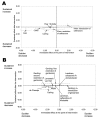Systematic review of antimicrobial drug prescribing in hospitals
- PMID: 16494744
- PMCID: PMC3373108
- DOI: 10.3201/eid1202.050145
Systematic review of antimicrobial drug prescribing in hospitals
Abstract
Prudent prescribing of antimicrobial drugs to hospital inpatients may reduce incidences of antimicrobial drug resistance and healthcare-associated infection. We reviewed the literature from January 1980 to November 2003 to identify rigorous evaluations of interventions to improve hospital prescribing of antimicrobial drugs. We identified 66 studies with interpretable data, of which 16 reported 20 microbiologic outcomes: gram-negative resistant bacteria, 10 studies; Clostridium difficile-associated diarrhea, 5 studies; vancomycin-resistant enterococci, 3 studies; and methicillin-resistant Staphylococcus aureus, 2 studies. Four studies provided strong evidence that the intervention changed microbial outcomes with low risk for alternative explanations, 8 studies provided less convincing evidence, and 4 studies provided no evidence. The strongest and most consistent evidence was for C. difficile-associated diarrhea, but we were able to analyze only the immediate impact of interventions because of nonstandardized durations of follow-up. The ability to compare results of studies could be substantially improved by standardizing methods and reporting.
Figures
References
-
- Behar P, Wagner MB, Freitas I, Auler A, Selistre L, Fossatti L, et al. Assessing the antimicrobial prescription request process in a teaching hospital in Brazil: regulations and training. Braz J Infect Dis. 2000;4:76–85. - PubMed
-
- European Union Conference. The Copenhagen Recommendations. Report from the invitational EU conference on the microbial threat. Ministry of Health, Ministry of Food, Agriculture and Fisheries, Denmark. 1998. [cited 2005 Nov 4]. Available from http://www.im.dk/publikationer/micro98/index.htm
-
- Shlaes DM, Gerding DN, John JF, Craig WM, Bornstein DL, Duncan RA, et al. Society for Healthcare Epidemiology of America and Infectious Diseases Society of America Joint Committee on the Prevention of Antimicrobial Resistance: guidelines for the prevention of antimicrobial resistance in hospitals. Clin Infect Dis. 1997;25:584–99. 10.1086/513766 - DOI - PubMed
Publication types
MeSH terms
Substances
Grants and funding
LinkOut - more resources
Full Text Sources
Other Literature Sources
Medical

